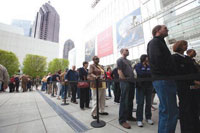 Museum attendance rises as the economy tumbles
Museum attendance rises as the economy tumblesIn our survey of 20 major institutions, two-thirds saw an increase in visitor numbers over the past three years
By Andrew Goldstein | From issue 208, December 2009
Published online 9 Dec 09 (Museums)
new york.
It may be because of the relative bargain of a museum ticket, an increased popular interest in contemporary art, or just a rainy summer, but admissions at the majority of art museums in the US have been holding steady through the recession—and many are dramatically on the rise. A survey by The Art Newspaper of 20 museums across the country found that two-thirds have experienced a clear increase in visitor numbers over the past three years.
The trend holds for institutions with free and paid admissions alike, and institutions that show contemporary art have seen the most clear-cut increase. New York’s Museum of Modern Art (MoMA), one of the nation’s most expensive museums at $20 per ticket, had the best year in its 80-year history, bringing in 2.8 million visitors between 2008 and 2009. The size of its membership rose to a record 120,000. The Solomon R. Guggenheim Museum’s Frank Lloyd Wright retrospective was its best-attended show yet, attracting 372,000 people. The New York museum has also broken its 2008 attendance record of just over one million.
The Museum of Contemporary Art Chicago saw a record 164,946 visitors attend this year’s Olafur Eliasson retrospective. Director Madeleine Grynsztejn cites a number of factors: the relatively low cost of a museum ticket, an increase in “staycations”, and a brighter spotlight on the city due to President Obama. The draw of the Art Institute of Chicago’s new Modern Wing, which opened in May, also helped.
A destination museum, such as Dia:Beacon in upstate New York is doing well, attracting 69,475 visitors so far this year. And the Massachusetts Museum of Contemporary Art (Mass MoCA) said this was its best year yet. Last year it attracted 142,000 people.
Admissions to the Metropolitan Museum of Art, New York, and the National Gallery of Art, Washington, DC, which have historic and modern art collections, also increased.
In some cases, as with the Art Institute of Chicago, the completion of ambitious expansion projects begun in the boom years contributed to heightened attendance. But other museums that have expanded, such as the Nelson-Atkins Museum of Art in Kansas City, Missouri, which opened its new Bloch Building in June 2007, saw the steepest drop-offs. The Walker Art Center, Minneapolis, has also seen a drop in numbers. Its new Herzog and de Meuron-designed wing opened in 2005.
Expensive blockbuster shows reliably pushed up admissions. In Atlanta, the High Museum of Art’s $18m deal for a three-year revolving loan of art from the Musée du Louvre in Paris resulted in the museum’s highest attendance to date, and its most popular individual show with this year’s “Louvre Atlanta: the Louvre and the Masterpiece”. Asked whether the visitor figures for such high-profile exhibitions was helped by the recession, High Museum director Michael Shapiro said: “I honestly don’t know how to answer that, but I can tell you that we did not diminish the quality of our programming. We weren’t going to give a smaller meal to the public because of the risk of the recession.” He added that the museum was in talks with the Louvre to begin a second collaboration, to be announced later this year, and that negotiations were also taking place with MoMA for possible major loans. “We were able to raise over $16m in sponsorship for [the Louvre show], our membership increased, our attendance increased, and our visibility around the world was enhanced dramatically. That’s priceless.”
Museums that had unusually successful shows in 2007 and 2008 have seen a levelling off of attendance as a result, such as the Los Angeles Museum of Contemporary Art (LA MoCA), which has struggled since its popular 2007 Murakami show at the Geffen Contemporary. Likewise the Walker Art Center, Minneapolis, had a record year in 2007 due to its Picasso and Frida Kahlo exhibitions.
The Hirshhorn Museum and Sculpture Garden, Washington, DC, has seen a dip in visitor numbers, but its director Richard Koshalek has plans to reverse the slide (The Art Newspaper, November 2009, p12).
Overall, many institutions have been pleasantly surprised by how well they have fared since the economic crisis. “We didn’t know if our attendance this past fiscal year was going to be so solid, so we were thrilled when we saw our numbers,” said Barbara Pflaumer, a representative of the Los Angeles County Museum of Art, where the Broad Contemporary Art Museum opened in February 2008. It has enjoyed a steady rise this year. “What we find from surveys we’ve done of our audience is that dollar for dollar people still find museums a greatly affordable bang for their buck,” she said.
 Museum attendance rises as the economy tumbles
Museum attendance rises as the economy tumbles